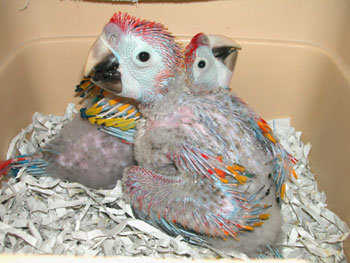Macaws!
When you hear “macaw,” you’re probably thinking more like
but those are just the types most often kept as pets (scarlet macaw, blue-and-yellow macaw, military macaw). There are bunches more, and they will all fuck you up if you mess with them. Even the little ones.
Above: Adult red-shouldered macaw.
You may be thinking, “Wow, that is a tiny macaw. I thought macaws were big honking birds.” But see, what defines the macaw is actually the length of the tail, the huge fuck-off beak, and that weird like almost-bare patch around its eyes and mouth. And yes, it is weird.
Above: A scarlet macaw’s weird face.
Like, what, bird, you think you’re a vulture or something? Anyway, most of them are pretty big, but not all of them. They’ve all got bizarro bird feet, though.
Above: Oh god, bird feet. (This arrangement is actually called zygodactyly, which usually means the bird is arboreal, not a hunter, and that you just won this round of Scrabble.)
Most of the larger macaws can be successfully hybridized in captivity to produce more unusual color arrangements, and probably in the hopes of creating some super-macaw monster, because why must man play god.
While tolerant of other birds, most macaws tend to stick to smaller flocks in the wild. Those legion of doom superflocks you see on nature documentaries are more like feeding aggregations, include many different types of parrots, and only occur at certain resource-heavy sites during nesting season.
Above: Oh god everybody run they’re nesting.
Macaws tend to pair off within their customary living group and raise one batch of 2-4 hideous babies per year.
Above: Hyacinth macaw chick whose eventual prettiness currently just adds to its horror.
Below: A pair of scarlet macaws have a similar problem.
In conclusion, birds remember when they were dinosaurs, and you should probably remember that they remember.
Parrots are in fact fairly clear on the point that they are STILL dinosaurs and are probably actually at least 6 feet tall, regardless of how you and your monkey face loom over them when they’re not flying. PS: THEY CAN FLY.
Seriously, though, watch out for those beaks. One of the favorite foods of many macaws is the brazil nut. Have you ever tried to crack open a brazil nut? These guys just casually shatter them. The hyacinth macaw (the gorgeous blue fellow at the top) can bring 1500 psi to bear with its beak, making them one of the most powerful biters in the animal kingdom.








